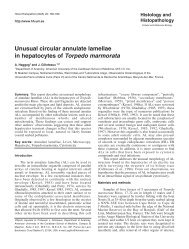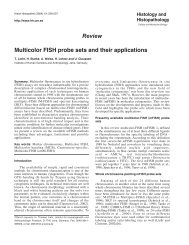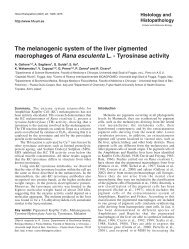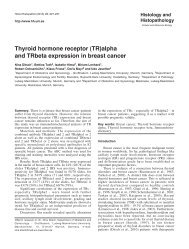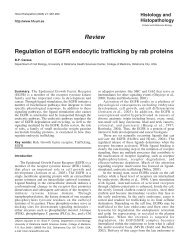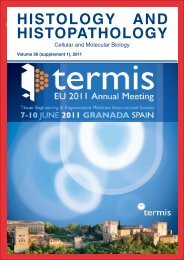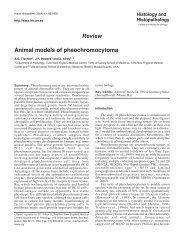Full text-PDF - Histology and Histopathology
Full text-PDF - Histology and Histopathology
Full text-PDF - Histology and Histopathology
Create successful ePaper yourself
Turn your PDF publications into a flip-book with our unique Google optimized e-Paper software.
926<br />
Effects of high protein diet on liver<br />
fruit, vegetables, non-fat dairy products, <strong>and</strong> whole<br />
grains has been shown to lower blood pressure (Appel et<br />
al., 1997). In other words limitation of these foods may<br />
raise blood pressure <strong>and</strong> may cause reduction in<br />
potassium, calcium, <strong>and</strong> magnesium coupled with an<br />
increase in sodium intake. High protein foods such as<br />
meat, poultry, seafood, eggs, seeds, <strong>and</strong> nuts are high in<br />
purines. Purines are broken down into uric acid, so<br />
excess consumption of these foods increases uric acid<br />
levels (Franzese, 2000). A surplus of protein in the<br />
system also increases urinary calcium loss, which may<br />
increase the risk of osteoporosis (Abelow et al., 1992;<br />
Feskanich et al., 1996; Barzel <strong>and</strong> Massey, 1998). High<br />
Protein Diets increase nitrogen in the tissues; as a result<br />
it stimulates amino acid degradation, followed by a large<br />
rise in urea production in liver (Morens et al., 2000). As<br />
a result, increased glomerular filtration rates (Hammond<br />
<strong>and</strong> Janes, 1998), renal <strong>and</strong> glomerular hypertrophy<br />
(Schrijvers et al., 2002), <strong>and</strong> decreased urine pH.<br />
(Schuette, 1980; Fellstrom et al., 1983) were observed.<br />
Increased uric acid levels may cause gout in sensitive<br />
individuals (Abelow et al., 1992; Franzese, 2000). In<br />
addition a decrease in calcium by urinating may increase<br />
the risk of kidney stones (Wiederkehr <strong>and</strong> Krapf, 2001;<br />
Reddy et al., 2002) also some types of cancer (Willet et<br />
al., 1990; Giovannucci et al., 1994).<br />
Moreover there has been research on mental<br />
performance of individuals <strong>and</strong> it was observed that HP<br />
diets lead to lower memory performance <strong>and</strong> lower level<br />
of concentration. These results suggest that carbohydrate<br />
<strong>and</strong> protein based diets have different effects on mental<br />
health. For example, Smith et al. (1988) compared the<br />
performance of three groups which have different diets<br />
(high-starch, high-sugar, or high-protein) on<br />
concentration <strong>and</strong> reported that the carbohydrate diet<br />
group has better performance than the others (Dye et al.,<br />
2000).<br />
Also Jorda et al. (1988) reported that the liver<br />
responds to the high-protein diet by a proliferation of<br />
normally functioning mitochondria.<br />
Apart from this histologic research there has not<br />
been another on the effects on liver glycogen storage on<br />
the metabolism those who are on high protein diets. For<br />
this reason the aim of this research is to identity<br />
histologicly the change dependence at term in the liver<br />
glycogen storage of the mice having HP diets.<br />
Materials <strong>and</strong> methods<br />
Forty male Swiss albino laboratory mice (Mus<br />
musculus), 60-90 day-old, average initial body weights<br />
24-42 g, were used in this study. The animals were<br />
housed in individual wireless steel cages under<br />
st<strong>and</strong>ardized conditions of temperature <strong>and</strong> light.<br />
The animals were divided into two groups. The first<br />
group was the one which was fed with HP diets (casein)<br />
the other was the control (C) group that was fed with<br />
st<strong>and</strong>ard diet. All the mice were given 12±2 g diet per<br />
day in separated cages. While the control group was<br />
given a st<strong>and</strong>ard diet the other was fed with 25% HP diet<br />
(Reeves et al., 1993). HP diet used on mice was prepared<br />
by powder (Table 1). This powder has made by fat-free<br />
casein <strong>and</strong> gluten-free. As 2.5 g powder was equal to 2.2<br />
g protein; this 25% HP was prepared, diluting distilated<br />
water 6.3±1 + 2.5 g powder.<br />
The animals were free access to water <strong>and</strong> were fed<br />
with their own diet for 30 days. At the end of 15th, 20th,<br />
25th <strong>and</strong> 30th days, 5 from each group were killed by<br />
cervical dislocation after being weighed. The livers were<br />
perfused with saline solution (0,9%) injected through<br />
main hepatic artery <strong>and</strong> then removed. Later the liver<br />
tissues were fixated with 80% ethanol for 12 hours. The<br />
fixated liver tissues were embedded in paraffin <strong>and</strong> cut<br />
into 5 µm sections <strong>and</strong> then stained with H-E, PAS <strong>and</strong><br />
silver (Bancroft <strong>and</strong> Stevens, 1996).<br />
In our study, we used analytically pure substances<br />
provided by Sigma-London Company, st<strong>and</strong>ard meal<br />
was provided by Samsun Yem Company <strong>and</strong> the protein<br />
which was used to prepare the HP diet was provided by<br />
Nutricia Cuijk-Holl<strong>and</strong> Company.<br />
Data gathered was examined in five different periods<br />
for normal distribution. For data a normal distribution<br />
analysis of variance (ANOVA) was used. Statistics were<br />
performed by the statistical package SPSS for Windows.<br />
The limit of significance was set at p



